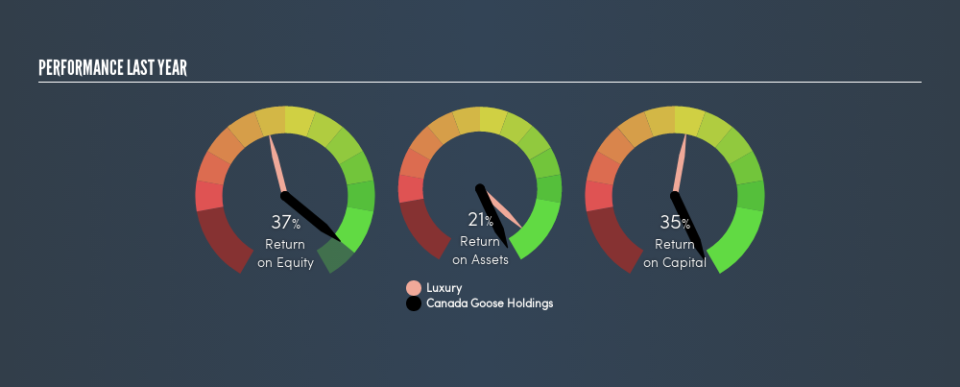Canada Goose Holdings Inc. (TSE:GOOS) Earns A Nice Return On Capital Employed

Today we are going to look at Canada Goose Holdings Inc. (TSE:GOOS) to see whether it might be an attractive investment prospect. Specifically, we’ll consider its Return On Capital Employed (ROCE), since that will give us an insight into how efficiently the business can generate profits from the capital it requires.
First, we’ll go over how we calculate ROCE. Second, we’ll look at its ROCE compared to similar companies. And finally, we’ll look at how its current liabilities are impacting its ROCE.
Understanding Return On Capital Employed (ROCE)
ROCE is a measure of a company’s yearly pre-tax profit (its return), relative to the capital employed in the business. All else being equal, a better business will have a higher ROCE. In brief, it is a useful tool, but it is not without drawbacks. Renowned investment researcher Michael Mauboussin has suggested that a high ROCE can indicate that ‘one dollar invested in the company generates value of more than one dollar’.
So, How Do We Calculate ROCE?
Analysts use this formula to calculate return on capital employed:
Return on Capital Employed = Earnings Before Interest and Tax (EBIT) ÷ (Total Assets – Current Liabilities)
Or for Canada Goose Holdings:
0.35 = CA$202m ÷ (CA$750m – CA$173m) (Based on the trailing twelve months to December 2018.)
So, Canada Goose Holdings has an ROCE of 35%.
See our latest analysis for Canada Goose Holdings
Is Canada Goose Holdings’s ROCE Good?
One way to assess ROCE is to compare similar companies. Using our data, we find that Canada Goose Holdings’s ROCE is meaningfully better than the 15% average in the Luxury industry. We would consider this a positive, as it suggests it is using capital more effectively than other similar companies. Regardless of the industry comparison, in absolute terms, Canada Goose Holdings’s ROCE currently appears to be excellent.
In our analysis, Canada Goose Holdings’s ROCE appears to be 35%, compared to 3 years ago, when its ROCE was 13%. This makes us think the business might be improving.
It is important to remember that ROCE shows past performance, and is not necessarily predictive. ROCE can be misleading for companies in cyclical industries, with returns looking impressive during the boom times, but very weak during the busts. ROCE is, after all, simply a snap shot of a single year. Future performance is what matters, and you can see analyst predictions in our free report on analyst forecasts for the company.
How Canada Goose Holdings’s Current Liabilities Impact Its ROCE
Short term (or current) liabilities, are things like supplier invoices, overdrafts, or tax bills that need to be paid within 12 months. The ROCE equation subtracts current liabilities from capital employed, so a company with a lot of current liabilities appears to have less capital employed, and a higher ROCE than otherwise. To counteract this, we check if a company has high current liabilities, relative to its total assets.
Canada Goose Holdings has total assets of CA$750m and current liabilities of CA$173m. As a result, its current liabilities are equal to approximately 23% of its total assets. A minimal amount of current liabilities limits the impact on ROCE.
Our Take On Canada Goose Holdings’s ROCE
This is good to see, and with such a high ROCE, Canada Goose Holdings may be worth a closer look. Of course you might be able to find a better stock than Canada Goose Holdings. So you may wish to see this free collection of other companies that have grown earnings strongly.
If you like to buy stocks alongside management, then you might just love this free list of companies. (Hint: insiders have been buying them).
We aim to bring you long-term focused research analysis driven by fundamental data. Note that our analysis may not factor in the latest price-sensitive company announcements or qualitative material.
If you spot an error that warrants correction, please contact the editor at editorial-team@simplywallst.com. This article by Simply Wall St is general in nature. It does not constitute a recommendation to buy or sell any stock, and does not take account of your objectives, or your financial situation. Simply Wall St has no position in the stocks mentioned. Thank you for reading.

 Yahoo Finance
Yahoo Finance 
